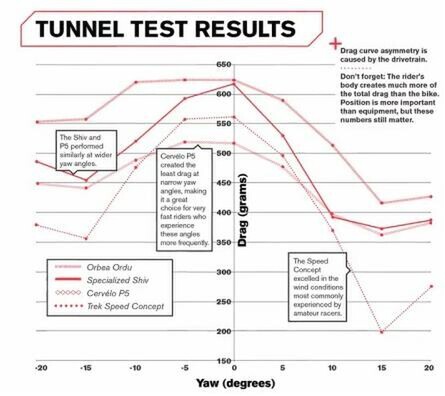Triathlete Magazine has made drag data available from a recent bout of Windtunnel testing involving the new Orbea Ordu, Specialized Shiv, Trek Speed Concept and Cervelo P5. Unfortunately the conclusions they draw from the data are rather simplistic.
Happily Speedtheory is here to do the complicated analysis and then present it in a way that (hopefully) makes it meaningful for our readers…
In the video shown at the link above they display a graph of the test results. So of course I have snipped the image and digitised the numbers to use in my models.
This isn’t a test that we can take as gospel in determining the rankings of these bikes. A few of the errors:
- Some bikes have S-bend bars which test better with no rider than the Ski-bends
- It’s not clear whether the Specialized Shiv was tested with the stock bars or Profile Aeria aftermarket bars
- For fair comparison to the Specialized Shiv the other bikes should have a bottle affixed somewhere to account for the internal bladder the Shiv offers (and it should have the straw sticking out)
- The Cervelo P5 was designed to be faster with a rider on board, despite Cervelo knowing that would hurt them in bike only testing. Though this effect may also apply for the Trek Speed Concept.
- I’d prefer to see them with X-Y tools to match the positions rather than holding up some bars and eyeballing it (I think that was just for demonstration purposes but it’s not confidence inspiring)
- Cervelo P5 & Orbea Ordu are UCI legal and other two bikes are not so it’s hard to know which market they’re trying to help
- Cervelo P5 configuration is not available to the market – has the Aduro bars (from the P5-Six) with the 3:1 fork from the P5-Three
So given that one of the objections to the Triathlete Magazine data is going to be that ‘Starky rode a record on the Ordu’ I thought it appropriate to examine that event.
Below is a chart that shows what the time gain would be going from the Ordu he used to one of the other bikes in the Windtunnel Testing that Triathlete Magazine performed. The graphs to the right show the AoA (yaw) distributions for riders at the extremes from the chart above. It’s important to note that even though a 6.30 rider is experiencing an average AoA of 8.3° they still have nearly 30% of the ride at or near 0° AoA as the wind didn’t pick up until two (2) hours into the ride (according to wunderground.com data).
The graphs to the right show the AoA (yaw) distributions for riders at the extremes from the chart above. It’s important to note that even though a 6.30 rider is experiencing an average AoA of 8.3° they still have nearly 30% of the ride at or near 0° AoA as the wind didn’t pick up until two (2) hours into the ride (according to wunderground.com data).
If we only considered the average yaw we would expect the Specialized Shiv to perform very similarly to the Cervelo P5 –  as their curves are so close in the 7°-10° region. But the Shiv and the Trek Speed Concept suffer against the P5 in the low AoA region so are not able to overcome that with performance at higher AoA.
as their curves are so close in the 7°-10° region. But the Shiv and the Trek Speed Concept suffer against the P5 in the low AoA region so are not able to overcome that with performance at higher AoA.
This is very clear for the faster ride times where the AoA distribution is in the very low end of the spectrum – the Cervelo P5 offers a clear advantage vs all competitors.
So the conclusion from the Triathlete Magazine data is that:
Starykowicz would have been faster on the P5, but not enough to have broken the magic 4 hour mark
“So” I hear you say “those figures are just for a flat course with very little wind. What about a windy course?”
To which I say – how about Ironman Kona 2012:
Much higher winds than IM Florida leads to much higher average AoA and this reflects in the Speed Concept being much closer to the P5 for fast riders. Additionally the Speed Concept becomes superior sooner and the Shiv gets into contention a lot more that in the low AoA situation at Florida.
Kona was windy from the beginning of the ride so there was never a 0° AoA situation which plays into the hands of the high AoA performance of the Speed Concept and Shiv.
It’s noteworthy that the results from actually modelling the data contradict the conclusion that Triathlete Magazine reached – where they show the Speed Concept having the lowest overall drag.
The real answer to ‘which bike is fastest?’ – it depends…
Obviously for a man-beast like Starykowicz any bike is fast, though some could be a little faster. For the rest of us it depends on how fast you’re going and how windy the races you like to do are.
And finally – I pointed out when the Ordu was released that their claimed 11% improvement in aero drag would bring the performance into line with the venerable Cervelo P3. At ~110g of drag behind the P5 it is pretty close to Cervelos data for the P3. So all the numbers above also give you P3 owners an indication of the gains possible by changing to one of the tested bikes.



